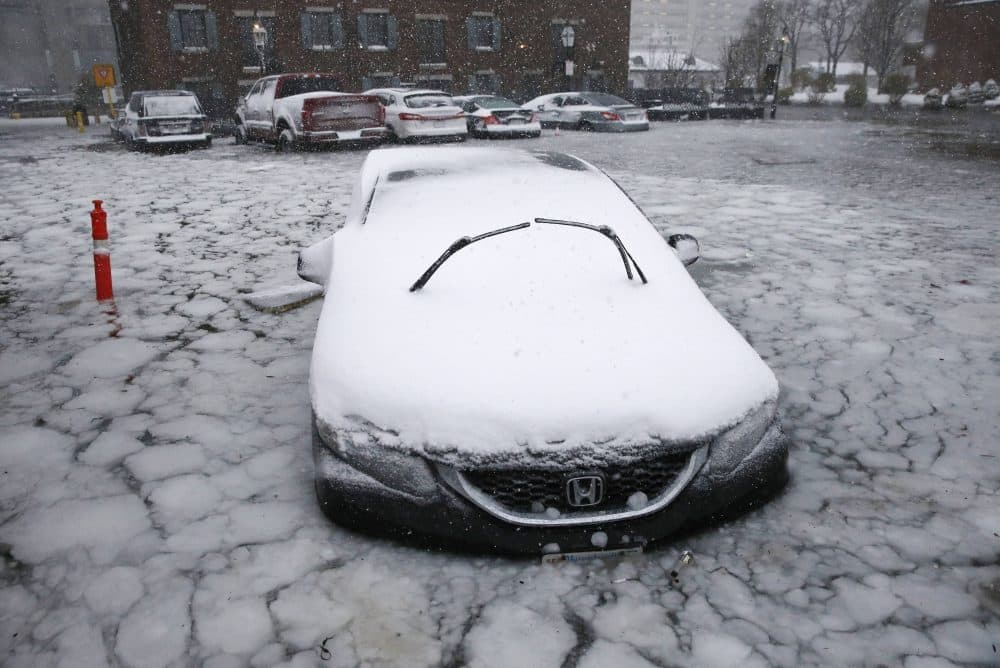Advertisement
New Zoning Codes Would Help Mitigate Boston Flood Risk, Report Says

"Rain bombs," storm surges and sea level rise.
Within the next century, increased rainfall and higher seas may lead to monthly flooding of many of Boston’s low-lying areas, like Dorchester and Fort Point Channel, and increased inundations of inland neighborhoods, like the South End.
And all that extra water could lead to billions of dollars of damage to roads, subways and buildings.
A new report from the University of Massachusetts Boston’s Sustainable Solutions Lab focuses on how state and local governments could help mitigate the harm.
Among the best ways to protect buildings from flooding, says the report: Alter zoning laws to create a new “Flood Resilience Overlay District,” which would expand beyond existing federal flood zones to encompass all areas that will have a 1 percent chance of flooding in any given year, for 2070 and beyond.
Experts say this larger district would offer a more realistic flood danger zone, and, along with building code changes, require that new buildings be able to withstand flooding. For example, buildings might have elevated first floors, or incorporate “sacrificial” floors — first stories that are designed to flood.
“As we watched hurricanes and extreme weather events hit various parts of the United States it became really clear that Boston was very vulnerable to both flooding and sea level rise,” says David Cash, dean of the Graduate School of Policy and Global Studies at UMass Boston and a leader of the Sustainable Solutions Lab. “Water seemed to be a big factor in the changing climate and one that would potentially have some of the largest impacts.”
New zoning and building codes would likely cost developers more money, both for new structures and renovations of older ones. Though the report’s recommendations are nonbinding, its authors expect pushback nonetheless.
“I think for any of these things, just like energy efficiency, there would be requirements that might make it more expensive in the short term but cheaper in the long term,” says Cash. “If your building is more resilient to flooding it will save the occupant, or the owner, money over time.”
Boston is particularly vulnerable to flooding, not only because it sits on the coast, but because much of it was built on landfill, just inches above high tide level.
Early builders “did not have the foresight to know that we would be emitting greenhouse gases into the air and making our sea levels rise,” says Stephanie Kruel, a senior environmental planner with the firm Vanasse Hangen Brustlin Inc. and lead author on the report. “A lot of our valuable real estate is along the waterfront, which makes it very vulnerable to coastal storms and eventually to tidal flooding.”
Other key recommendations in the new report include updating the state Wetlands Protection Act to recognize that climate change will affect developed and undeveloped wetlands differently; and working with the U.S. Army Corps of Engineers to develop a more flexible approach to permitting "water work," which includes dredging and filling in U.S. waterways.
"I think we need to start to have a different perspective about water work and what kind of impacts we're allowed to have," says Kruel, who adds that city planners may decide they want to add fill to the waterfront to “shore up the shoreline.”
The report also suggests that the governor and the mayor of Boston could establish an Infrastructure Coordinating Committee with representatives from transportation, energy and water and sewer, and telecommunications sectors, all of which be affected by rising waters in Boston, but don’t necessarily fall under the city’s jurisdiction.
And the authors propose a regional Coastal Flood Protection Agency, along the lines of Massachusetts Water Resources Agency, that would be formed around watersheds, rather than municipal boundaries.
“The urgency of climate change requires transformational change in governance, says UMass Boston's Cash. “We will not be able to solve this if every city and every town is acting on their own.”
The report, "Governance for a Changing Climate: Adapting Boston’s Built Environment for Increased Flooding," is the third released this year from the Sustainable Solutions Lab, offering recommendations on how the city can deal with the consequences of climate change. The first looked at the projected costs for guarding Boston against the effects of climate change. The second advised against building a harbor barrier to protect the city from flooding. The reports were sponsored by the Green Ribbon Commission, a group of Boston business and civic leaders developing strategies for reducing — and coping with — the effects of climate change in the city, in coordination with Boston’s Climate Action Plan.
